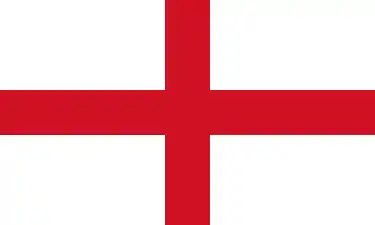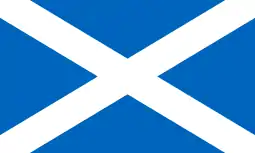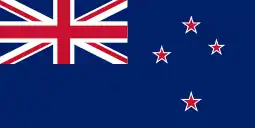Blackheath F.C.
Blackheath Football Club is a rugby union club based in Well Hall, Eltham in south-east London.
 | ||
| Full name | Blackheath Football Club | |
|---|---|---|
| Union | Kent RFU, Middlesex RFU | |
| Nickname(s) | Club | |
| Founded | 1858 | |
| Location | Well Hall, Eltham, Greenwich, London, England | |
| Ground(s) | Well Hall (Capacity: 1,650 (550 seats)) | |
| President | Alan Thompson | |
| Captain(s) | Markus Burcham | |
| League(s) | National League 1 | |
| 2019–20 | 5th | |
| ||
| Official website | ||
| blackheathrugby | ||
The club was founded in 1858 and is the second oldest open rugby club in the world after Liverpool FC Rugby Club thst was founded a year earlier in 1857. "Open" in this context means that membership was open to anyone, not merely those attending, or old boys from, a particular institution (e.g. a school, university or hospital). It is also the third-oldest rugby club in continuous existence in the world, after Dublin University Football Club and Edinburgh Academical Football Club. The Blackheath club also helped organise the world's first rugby international (between England and Scotland in Edinburgh on 27 March 1871) and hosted the first international between England and Wales ten years later – the players meeting and getting changed at the Princess of Wales public house. Blackheath, along with Civil Service F.C., is one of the two clubs that can claim to be a founder member of both The Football Association and the Rugby Football Union.
The club currently play in National League 1, the third tier of the English rugby union system, with matches played at Well Hall, after a move from Rectory Field in Blackheath at the end of the 2015–16 season.
History
Early history
| Wikisource has original text related to this article: |
The institution was founded as "Blackheath Football Club" in 1858 by old boys of Blackheath Proprietary School who played a "carrying" game of football made popular by Rugby School. When the old boys played against the current pupils supporters would shout for either "Club" or "School" accordingly. This is why to this day supporters of BFC shout for "Club", not for "Blackheath".
In 1863 the club developed the tactic of passing the ball from player to player as an alternative to the solo break and the "kick and follow-up".
In 1863 Blackheath was a founder member of The Football Association which was formed at the Freemasons' Tavern, Great Queen Street, on Lincoln Inn Fields, London 26 October 1863 with the intention to frame a code of laws that would embrace the best and most acceptable points of all the various methods of play under the one heading of "football". Francis Maule Campbell, a member of Blackheath, was elected treasurer. At the fifth meeting Campbell argued that hacking was an essential element of 'football' and that to eliminate hacking would "do away with all the courage and pluck from the game, and I will be bound over to bring over a lot of Frenchmen who would beat you with a week’s practice."[1] At the sixth meeting on 8 December Campbell withdrew Blackheath, explaining that the rules that the FA intended to adopt would destroy the game and all interest in it. Other rugby clubs followed this lead and did not join the Football Association. In this way the great divide between soccer and rugby took place.
In December 1870 Edwin Ash, secretary of Richmond Football Club published a letter in the papers which said, "Those who play the rugby-type game should meet to form a code of practice as various clubs play to rules which differ from others, which makes the game difficult to play." On 26 January 1871 a meeting attended by representatives from 22 clubs was held in London at the Pall Mall Restaurant. As a result of this meeting the Rugby Football Union (RFU) was founded. Three lawyers who had been pupils at Rugby School drew up the first laws of the game which were approved in June 1871. The Club is one of seven of the original twenty-one clubs to have survived to this day.
Later history

Blackheath initially played its matches on the Heath (meeting and changing at the Princess of Wales public house) but occasional interruptions from spectators led the club to move, initially to a private field (Richardson's Field) in Blackheath before moving to the Rectory Field in 1883.
On 27 March 1871, England (captained by Blackheath's captain and with three other Club players in the 20-strong side) played Scotland at Raeburn Place, Edinburgh, losing by one point. This was the first international rugby union game in history. Richardson's Field hosted the first England v. Wales fixture on 19 February 1881, which England won, again with four Club players in the side. In 1982 Blackheath joined the list of winning teams at the Glengarth Sevens at Stockport R.U.F.C.
Blackheath were one of the opponents for The Original All Blacks on their 1905–06 northern hemisphere tour, the first ever New Zealand rugby union tour outside of Australasia. The touring side ran out 32–0 victors.
After 158 years it was announced that the 2015–16 season would be the last playing at the historic Rectory Field as the club had made the difficult decision to move to their training ground, Well Hall in Eltham, for the 2016–17 season to maximise matchday revenue and to continue developing for the future.[2][3] Blackheath played their last game at the Rectory Field on 30 April 2016, beating Blaydon 45–17.[4]
Current standings
| |||||||||||||||||
| Played | Won | Drawn | Lost | Points for | Points against | Points diff | Try bonus | Losing bonus | Points | ||||||||
|---|---|---|---|---|---|---|---|---|---|---|---|---|---|---|---|---|---|
| 1 | Richmond (C) | 25 | 20 | 0 | 5 | 741 | 347 | 394 | 12 | 5 | 97 | ||||||
| 2 | Rosslyn Park | 25 | 18 | 1 | 6 | 728 | 472 | 256 | 12 | 4 | 90 | ||||||
| 3 | Rams | 25 | 19 | 0 | 6 | 680 | 521 | 159 | 16 | 2 | 89[lower-alpha 1] | ||||||
| 4 | Chinnor | 25 | 16 | 2 | 7 | 631 | 502 | 129 | 13 | 4 | 85 | ||||||
| 5 | Blackheath | 25 | 16 | 1 | 8 | 621 | 511 | 110 | 12 | 4 | 82 | ||||||
| 6 | Plymouth Albion | 25 | 13 | 2 | 10 | 698 | 617 | 81 | 14 | 5 | 75 | ||||||
| 7 | Darlington Mowden Park | 25 | 13 | 1 | 11 | 796 | 517 | 279 | 14 | 6 | 74 | ||||||
| 8 | Old Elthamians | 25 | 13 | 1 | 11 | 574 | 501 | 73 | 10 | 4 | 68 | ||||||
| 9 | Cambridge | 25 | 12 | 2 | 11 | 571 | 560 | 11 | 11 | 4 | 67 | ||||||
| 10 | Cinderford | 23 | 13 | 0 | 10 | 526 | 452 | 74 | 7 | 6 | 65 | ||||||
| 11 | Sale FC | 25 | 12 | 0 | 13 | 621 | 602 | 19 | 10 | 6 | 64 | ||||||
| 12 | Bishop's Stortford | 24 | 9 | 2 | 13 | 599 | 595 | 4 | 12 | 9 | 61 | ||||||
| 13 | Birmingham Moseley | 25 | 8 | 0 | 17 | 505 | 649 | −144 | 4 | 8 | 44 | ||||||
| 14 | Rotherham Titans (R) | 25 | 6 | 1 | 18 | 490 | 727 | −237 | 7 | 7 | 40 | ||||||
| 15 | Canterbury (R) | 25 | 2 | 0 | 23 | 357 | 824 | −467 | 2 | 6 | 16 | ||||||
| 16 | Hull Ionians (R) | 24 | 1 | 1 | 22 | 330 | 1071 | -741 | 3 | 2 | 11 | ||||||
| |||||||||||||||||
| Green background is the promotion place. Pink background are relegation places. Updated: 14 March 2020 Source: "National League 1". NCA Rugby. | |||||||||||||||||
Modern club
- Blackheath FC's first team currently plays in National Division 1 in England, but the club fields many sides.
- The mini and junior sections have their own home ground, based at Kidbrooke Road, Well Hall, London, SE9.
- The club also has two women's teams, the first XV winning the Championship South East 2 League back to back in seasons 2015–16 and 2016–17.
- The club provides sections ranging from under-6's right through to under-18's, and has experienced success at all levels.
- The mini section ran its first Mini Rugby Festival at Eltham College on 25 November 2007.
- The club also runs a rugby academy, which started in its current format in 2013, for boys who wish to continue their academic studies alongside playing rugby. The academy is also based at Well Hall.
Notable players
- See also Category:Blackheath F.C. players
 David Allen – openside flanker who played at Club for 13 seasons between 2004 and 2016, scoring 147 league tries from 274 appearances and becoming the all-time top try scorer in tier 3. Gained 8 caps for the England Counties XV as well as appearing for the Barbarians.
David Allen – openside flanker who played at Club for 13 seasons between 2004 and 2016, scoring 147 league tries from 274 appearances and becoming the all-time top try scorer in tier 3. Gained 8 caps for the England Counties XV as well as appearing for the Barbarians. Harold Dingwall Bateson.
Harold Dingwall Bateson. Thomas Batson
Thomas Batson George Burton (rugby union)
George Burton (rugby union) Mike Campbell-Lamerton.
Mike Campbell-Lamerton. Charles Arthur Crompton, played in England's first international
Charles Arthur Crompton, played in England's first international C.B. Fry
C.B. Fry John Gallagher, All Black and member of the team that won the inaugural Rugby World Cup in 1987.
John Gallagher, All Black and member of the team that won the inaugural Rugby World Cup in 1987..svg.png.webp) Stephen Gray, played for Canada 1987,91,95 World Cups.
Stephen Gray, played for Canada 1987,91,95 World Cups. Thomas Gubb
Thomas Gubb Stan Harris
Stan Harris Dhani Jones
Dhani Jones Aadel Kardooni, England A
Aadel Kardooni, England A JEC 'Birdie' Partridge
JEC 'Birdie' Partridge Alexander William Pearson (born 1854)
Alexander William Pearson (born 1854) Charles Pillman. Played for England 18 times before WW1.
Charles Pillman. Played for England 18 times before WW1. Robert Pillman. Charles Pillman's younger brother who played for England against France in 1914 and was killed in Belgium in 1916
Robert Pillman. Charles Pillman's younger brother who played for England against France in 1914 and was killed in Belgium in 1916 E H D Sewell sports writer and cricketer
E H D Sewell sports writer and cricketer Charles Sherrard (1849–1938), played in England's first international
Charles Sherrard (1849–1938), played in England's first international Joe Simpson.
Joe Simpson. Mickey Skinner "The Munch".
Mickey Skinner "The Munch". Graham Standing
Graham Standing Frederick Stokes (1850–1929),[6] the first captain of the England national rugby union team.
Frederick Stokes (1850–1929),[6] the first captain of the England national rugby union team. Lennard Stokes (1856–1933),[6] former captain of the England national rugby union team.
Lennard Stokes (1856–1933),[6] former captain of the England national rugby union team. Henry Taylor (rugby union)
Henry Taylor (rugby union) Rob Webber.
Rob Webber. Jack Anthony Kendall. England under 18 under 19 England Deaf. The youngest player in the club's history to have played for the first XV. Signed to London Irish PLC In 2003. Jack also spent five seasons as a professional rugby league player.
Jack Anthony Kendall. England under 18 under 19 England Deaf. The youngest player in the club's history to have played for the first XV. Signed to London Irish PLC In 2003. Jack also spent five seasons as a professional rugby league player.
Fictional players
- Dr. Watson, character from the Sherlock Holmes stories
Honours
- Middlesex Sevens (2): 1932, 1958
- Gala Sevens (1): 1957
- Kent Cup (16): 1891, 1972, 1977, 1978, 1980, 1981, 1982, 1983, 1984, 1985, 1986, 1987, 1996, 2003, 2009, 2013
- Glengarth Sevens Main Event (1): 1982
- Glengarth Sevens Davenport Plate (1): 1983
- National Division Three South (1): 2003–04[7]
See also
Notes
- Rams deducted 5 points due to an issue with their Payment of Players declaration during the 2018–19 National League 2 South season.[5]
References
- Richard Holt,Sport and the British: A Modern History, Oxford University Press, 1990 ISBN 0-19-285229-9, p. 86
- "BFC Executive Statement 9.12.15". Blackheath Rugby. 9 December 2015.
- "Blackheath to leave the Rectory Field". Rolling Maul. 10 December 2015.
- "The Big Match: Blackheath v Blaydon". Blackheath Rugby. 29 April 2016.
- "RAMS DEDUCTED 5 POINTS". Rams RFC (Pitchero). 26 February 2020. Retrieved 27 February 2020.
- Steve Lewis, One Among Equals, 2008, pp9-10 (Vertical Editions:London)
- "Archived copy". Archived from the original on 21 May 2014. Retrieved 21 May 2014.CS1 maint: archived copy as title (link)